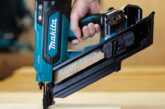
In the latest instalment of the Makita Tech Talk series, Charles Shaw, hire and construction division manager, explains how the company’s new generation of dust management solutions are helping to keep construction professionals safe on-site.
Not all dust is harmful, but the types produced on construction sites often are. In particular, respirable crystalline silica (RCS) is one to avoid. The harmful dust emerges when materials like concrete, masonry and rock are processed, which can include breaking, cutting, drilling and sanding. RCS is a miniscule particle, some 100 times smaller than the average grain of sand. Interacting with the particle can cause serious issues including silicosis, autoimmune disease and respiratory problems. As of 2019, silica trails only asbestos as a cause of occupational cancer deaths.
All in all, you’re five times more likely to die from a respiratory illness brought upon by dust inhalation than you are in a car crash, and the HSE has formulated a series of legal requirements and guidance around dust management. This guidance can be found in material such as CIS36 and CIS69 available from the HSE. If you’re found to be in material breach of the law, firms can face an FFE (fee for intervention) that can be charged as an hourly fee, which is currently £154 per hour. Failing to understand your legal requirements, or failure to implement control measures could result in a significant fine. What’s more, reactive compliance costs, as well as the cost of lost work will pose an additional cost to your business.
Companies have a legal duty to protect their operatives from exposure to dust. There are three classifications of filter system; L Class, M Class and H Class. The L, M and H stand for Low, Medium and High, respectively.
The recommended on tool extraction systems for on site are M Class dust extraction, which can extract <0.1% of dusts with maximum allowable concentrations (MAC) > 0.1mg/m3, and H class machine, which extracts <0.005% dusts with maximum allowable concentrations (MAC) <0.1 mg/m3. To help the sector get a better grip on its dust management problem, Makita now offers dust management solutions rated at least M Class or H Class. The M Class extractors are suitable for the majority of construction tasks. To this end, the machines can effectively remove dusts involving mica, china clay, gypsum, wood dust and silica dusts. An L (Low) class unit is only suitable for lower-toxicity dusts like gypsum in plasterboard. The specification of the extraction unit must be suitable for the tool and the task.
The innovative “M” and “H” class units are designed with features giving the users options to control dusts respective to the tool used. These extraction units are compact in design and have the capability to contain up to 40ltrs of captured material. The dust extractor automatically activates when connected to a power tool. Similarly, the machine is fitted with an air flow sensor that beeps when air flow is reduce by a clogged filter or full tank.
These units would form part of a LEV (Local exhaust ventilation) system which requires regular servicing and testing to ensure that it remains effective. This requirement can be achieved by a Thorough Examination and Test (TExT), which is needed at least every 14 months to ensure that the extraction units perform as intended. As an owner of an on-tool extraction system you would need to arrange for this TExT to be carried out by a competent person and keep suitable records to show that it has been completed. Makita offers this service to its customers.
![]()







